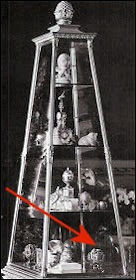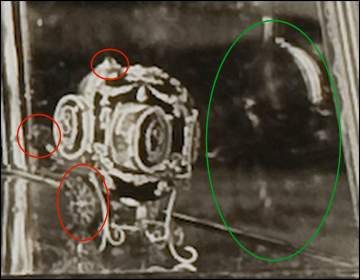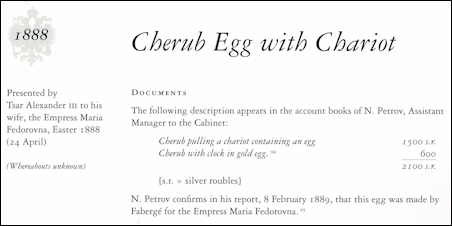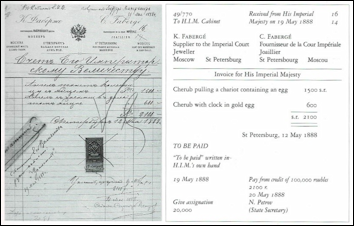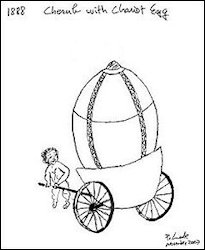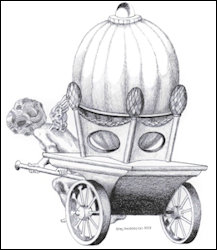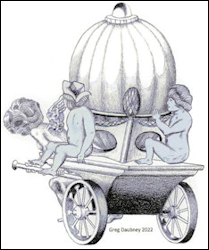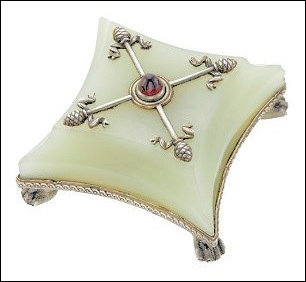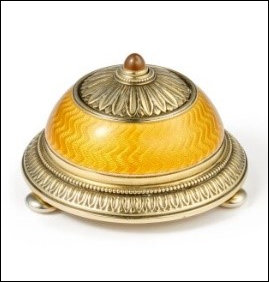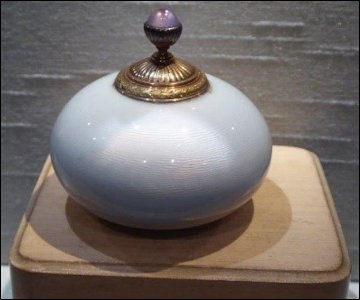Fall and Winter 2022
Fabergé’s 1888 Cherub Egg with Chariot – Reconstructing a Lost Treasure!
By Greg Daubney (UK) and Chad Solon (USA)
Part of the allure of studying the art of Fabergé is discovering objects lost in the chaos and aftermath of the 1917 Russian Revolution. Out of 50 Imperial Easter Eggs by Fabergé presented to the Russian Empresses Maria Feodorovna (1847-1928) and Alexandra Feodorovna (1872-1918), six are still missing today – 1886 Hen with Sapphire Pendant Egg, 1888 Cherub Egg with Chariot, 1889 Nécessaire Egg, 1897 Mauve Egg with Three Miniatures, 1903 Royal Danish Egg, and the 1909 Alexander III Commemorative Egg. Comprehensive archival data published by researchers over the years for the 1888 Cherub Egg with Chariot is summarized and updated in our essay:
Fabergé, Tatiana, Proler, Lynette G., and Valentin V. Skurlov.
The Fabergé Imperial Easter Eggs, 1997, pp. 100, 237.
Lowes, Will, and Christel Ludewig McCanless, Fabergé Eggs: A Retrospective Encyclopedia, 2001, pp. 24-25, and its accompanying Fabergé Imperial Egg Chronology on the Fabergé Research Site.
Cherub Egg with Chariot Updates appeared in the Fabergé Research Site, Imperial Egg Discoveries, November 2007, (“Two Lost Fabergé Imperial Eggs Discovered in an Archival Photograph” by Anna and Vincent Palmade) | 04.08 (Anniversary Edition) | Winter 11-12 | Summer 14 | Summer 15 | Summer 18
Cherub Egg with Chariot on Miek’s Fabergé Eggs Website (Updated December 14, 2019)
A complete photograph of the lost Cherub Egg with Chariot has not yet been found. A photograph of the Maria Feodorovna vitrine in the von Dervis Mansion exhibition from March 9-15 (o.s.) 1902 is extant with two reflections of the egg (green circle), and its decorative sapphire gem at the top, a cherub, and one spoked wheel (red circles). Verified historic details for the years 1888-1922 allow researchers to attempt reconstructions of the egg’s outer appearance, perhaps leading to its rediscovery.
1902 Photograph, von Dervis Mansion Exhibition Vitrine Feature Maria Feodorovna’s Fabergé Loans
with the 1888 Cherub Egg with Chariot.
Green Circle: Reflection of the 1888 Cherub Egg. Red Circles: Decorative
Sapphire Finial at the Top, Cherub, Spoked Wheel behind the 1893 Fabergé Caucasus Egg
(Unknown author, Public domain, via Wikimedia Commons)
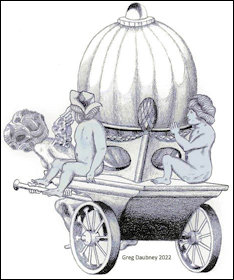 2022 Artist’s Rendering of
2022 Artist’s Rendering of
Cherub Egg with Chariot
(© Greg Daubney)
This design is based directly on the reflection in
the vitrine glass, so is a mirror image. In
reality, the figures face toward the right and
are on the opposite side of the chariot.
The missing egg consists of a chariot with an egg pulled by a cherub, leaning forward from the effort. The chariot is made up of a rectangular platform supported by two spoked wheels. On top of the platform is a decorative railing which forms a kind of basket. Sitting on it is the egg, which has vertical ribs and a sapphire finial identified in its 1888 Fabergé invoice
1, cherub and chariot are made from gold, or may simply be gilded. Some part of the object is decorated with small diamonds, cited in the 1917 description below. Photographic enlargements were used to identify the various components.
Chronological Review of Cherub Egg Timeline (1888-1922) Based on Published Archival Sources
1888 Documents from His Majesty’s Imperial Cabinet Include an Original Faberge Invoice (right):
Cherub pulling a chariot containing an egg, 1500 rubles and Cherub with clock in gold egg, 600 rubles.
(Faberge, Tatiana, et al., 1997, pp. 100, 237)
Many Fabergé imperial eggs open to reveal surprises. Based on the wording of this invoice, it is unclear whether the second item was meant to go inside the first, or are there are possibly two separate items.
 (Fabergé, Tatiana, et al., 1997, p. 100)
(Fabergé, Tatiana, et al., 1997, p. 100)
Maria Feodorovna kept the egg initially at the Gatchina Palace, their primary residence outside St. Petersburg. By 1917, the Cherub Egg was in the Anichkov Palace, Maria Feodorovna’s primary residence in St. Petersburg after she was widowed in 1894. Based on the 1997 publication by Carl Fabergé’s great grand-daughter, Tatiana Fabergé (1930-2020), and her research associates the archival time line shared for the years 1888-1922 is very helpful.
Archival Data from Two Other Sources (A. and B.)
 A.
A.
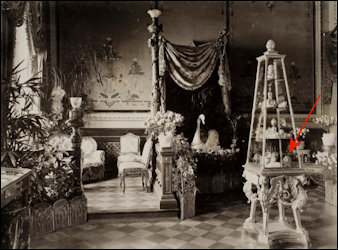 B.
B.
A.
April 14 – November 12, 1900 Exposition Universelle in Paris – only known photograph with a Fabergé display on loan from the Russian Imperial family. (von Habsburg, Géza, and Marina Lopato.
Fabergé: Imperial Jeweler, 1993, p. 117).
A contemporary account of the venue is extant, “Collection Impériale – Les oeufs de Pâques de l’ímpératrice – Un coin du foyer impérial – Bibelots augustes”. Le Matin, Lundi, 14 Mai 1900. (Miek’s Fabergé Eggs Website, the 1900 Paris Exposition Universelle contains the entire Le Matin article. According to the newspaper account, 14 Imperial eggs were shown. The Fabergé firm had delivered a total of 20 Imperial eggs to both Empresses before the eggs for 1900 were presented. The identities of seven eggs displayed are known, so it is possible the Cherub Egg was shown? No exhibition catalog.)
B. March 9-15 (o.s.), 1902 Charity Exhibition of Fabergé Artistic Objects, Old Miniatures, and Snuff Boxes, von Dervis Mansion, St. Petersburg, Russia, included two vitrines containing the Easter Eggs owned by the Empresses Marie Feodorovna and Alexandra Feodorovna. Photograph above was published in the Russian magazine Niva, 1902, No. 12, p. 233. (runivers.ru; further details with photographs of the venue, Courtesy Miek’s Fabergé Eggs Website, Early Imperial Egg Exhibitions) Fifteen or more eggs were shown. No exhibition catalog. (Lowes and McCanless, 2001, p. 251).
(1917 and 1922 entries are Fabergé, Tatiana, et al., 1997, p. 100)
Two archival sources (C. and D.) – a sale catalog from Lord & Taylor (1933 or 1934?) and a 1941 auction lot description from the Parke Bernet Galleries, both in New York City, do not match the above Cherub egg descriptions:
C.
 (Fabergé, Tatiana, et al., 1997, p. 100)
(Fabergé, Tatiana, et al., 1997, p. 100)
 Lord & Taylor Sale Catalog (1933 or 1934?)
Lord & Taylor Sale Catalog (1933 or 1934?)
(Courtesy: McCanless Archives)
D.
 Parke Bernet Galleries, New York. French & English Furniture, the Ethel G. Douglas Collection of Wedgwood Ware, Imperial Russian Art Objects,
Parke Bernet Galleries, New York. French & English Furniture, the Ethel G. Douglas Collection of Wedgwood Ware, Imperial Russian Art Objects,
Lalique and Favrile Glass, Laces, Silver, Paintings, Rugs, Property of Mrs. Ethel Gunton Douglas, Removed from 834 Fifth Avenue,
New York, … With a Few Additions from Other Owners, Friday-Saturday, September 26-27, 1941
(Courtesy: McCanless Archives)
C. Armand Hammer sold his “Russian Imperial Art Treasures” at Lord & Taylor, New York, from January 3 – February 21, 1933, and November 3 – December 1, 1934. The printed catalog illustrated above is not dated. (Lowes and McCanless, 2001, pp. 16-17
2). Assuming it is the Cherub Egg in the Armand Hammer catalog description – the provenance and the word “miniature” are incorrect.
D. The egg’s small size (2 or 3 inches) stated in the Douglas auction catalog (September 26-27,1941) does not match the lost Cherub Egg which should be in the size range of 11.5 cm / 4.5” in comparison to other imperial Easter eggs by Fabergé. Despite this, the description is still interesting and is the only known reference to a possible location of the missing egg after 1922.
Reconstructions of the Cherub Egg with Chariot3 (2007-2022)
In 2007, while studying the 1902 von Dervis photographs, Vincent and Anna Palmade discovered an intriguing image which appeared to be the missing egg.4 Their drawing shows the cherub looking backwards and pulling a chariot with an egg with diamond bands on it, and four years later the cherub was revised looking forward and the egg is ribbed. Their 2011 version features a more elaborate gilded chariot decorated with swags and bows. In 2014, co-author of this article Greg Daubney after seeing the re-discovered 1887 Third Imperial Egg by Fabergé at the Wartski London unveiling, created an accurate to-scale drawing based on reflections seen in 1902 photograph. In 2021, two digital versions appeared on the Internet.
Artist Renderings over the Years
2014, 2019, and 2022. Designs drawn to scale from the von Dervis photograph
(Courtesy and © Greg Daubney)
Digital Versions of the Cherub Egg
 2021 Cherub with Chariot Egg, modern re-creation
2021 Cherub with Chariot Egg, modern re-creation
(PBrieux, CC BY-SA 4.0, via Wikimedia Commons)
-
Egg is accurate.
-
Cherub’s pose is wrong, wings are too long,
and should probably be nude.
-
Chariot is wrong shape.
-
Wheels have wrong number of spokes.
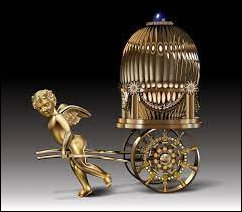 2021 Cherub with Chariot Egg, modern re-creation
2021 Cherub with Chariot Egg, modern re-creation
(KDS4444, CC BY-SA 4.0, via Wikimedia Commons)
-
Egg is accurate.
-
Cherub is correct pose and style.
-
Upper portion of chariot similar to von Dervis
photograph.
-
Wheels are too ornate but have correct
number of spokes.
Fresh Look at the Cherub Egg with Chariot (2019-2022)
After carefully reviewing the 1902 von Dervis photographs, the authors now believe:
-
Cherub pulling the chariot is facing forward and the viewer is looking at the hair on the back of the head.
-
A single shaft is held with both hands by the cherub, the right arm crossing the chest at the front and the left arm extended further back. It is unclear, if there is another shaft on the opposite side of the cherub.
-
The cherub or ‘angel’ most likely has small wings as seen in other examples of Fabergé’s cherubs. Greg Daubney used similar cherubs in his artistic 2022 rendering from the 1891 Alexander III Silver Anniversary Clock by Fabergé for his inspiration, since no wings were visible in the photograph.
-
The historic descriptions of the egg mention a sapphire and diamonds. It is clear from the photograph the sapphire finial is on the top of the egg, but there is no hint about the diamonds. Perhaps they are arranged on the surface of the egg dividing the egg into panels, or do they surround the cabochon sapphire on top of the egg? A similar sapphire configuration is seen on the 1890 Danish Palaces Egg by Fabergé in its finial.
-
The egg’s surface of Cherub Egg appears to be stylistically very similar with its ribbed pattern to the 1887 Third Imperial Egg discovered in 2014. It is not an unusual practice in Fabergé’s oeuvre, since designs were often repeated, although never directly copied.
-
One of the biggest challenges in reconstructing the egg is the composition of the ‘basket’ of the chariot, which is hidden by the 1893 Caucasus Egg and only seen in a distorted reflection. The authors have concluded the chariot body is essentially a square base on wheels which acts as a stand for the egg and gives it support, and includes Fabergé’s usual neoclassical style, perhaps with floral swags between the posts. There seems to be a circular ring on which the egg sits, and is held in place by posts, which are linked together.
-
An intriguing and alternate design is also possible (Daubney’s 2022 rendering). Looking closely at the reflection it appears there may be two figures on the chariot. One of them seems to be wearing a hat and sitting on the edge with its legs hanging over the side, while the other is hanging on to the back of the chariot. There is no mention of additional figures in the invoice nor in any descriptions of the egg. This is not difinitive, because Fabergé invoices and Imperial inventories are sometimes vague and neglect details.
-
It is possible to estimate the height of the lost Cherub Egg by comparing the height of the 1893 Caucasus Egg (9.2 cm / 3.6”) by allowing for the small change in perspective between these two eggs. The Cherub Egg is ca. 11.5 cm / 4.5” from the bottom of the wheels to the top of the egg.
Our Conclusions
There have been no confirmed sightings of the egg nor additional archival evidence for the 1888 Cherub Imperial Easter Egg since 1922, when the egg is described as a flask, possibly a translation error. Two assumptions for the years 1934 and 1941 studied more closely, do not properly identify the lost egg. To find the Cherub with Chariot Egg or additional archival documentation, the following resources – if extant – might be helpful:
-
Clearer images of the lost egg, perhaps in photographs of the Fabergé pavilion at the 1900 Exposition Universelle in Paris.
-
In situ egg photographs at the Gatchina or Anichkov Palaces before 1917.
-
Armand Hammer’s travelling exhibition details in the 1930’s, access to the Ethel G. Douglas archives related to her 1941 auction, or a long-forgotten auction catalog.
-
Hans Nadelhoffer in his book about the Cartier family and jewelry firm in Paris and Russia5 mentions visits to the Hermitage countless times, … and concludes with this statement, “… and of course, at Fabergé’s eggs, photographs of which Cartier [Louis, 1875-1942] was to take back with him to Paris.” Are these photographs extant in the Cartier Archives?
The authors wish to thank all contributors past and present for their dedication in sharing details leading perhaps to the rediscovery of the 1888 Cherub with a Chariot Egg by Fabergé.
ENDNOTES:
1 Fabergé, Tatiana, et al., 1997, pp. 100, 237.
2 Two publications for background information on Hammer sales: Williams, Robert C. Russian Art and American Money, 1979, and Hammer, Armand, Hammer: Witness to History, 1987.
3 An alternate name, Cherub with Chariot Egg, used in published texts has been changed to Cherub Egg with Chariot in this text, the more commonly used name for the egg.
4 Palmade, Anna and Vincent, “Two Lost Fabergé Imperial Eggs Discovered in an Archival Photograph” Fabergé Research Site, Imperial Egg Discoveries, November 2007.
5 Nadelhoffer, Hans. Cartier: Jewelers Extraordinary, 1984, pp. 120-121.
Restoration of Hand Fans with Fabergé Montures
By Christel Ludewig McCanless (USA)
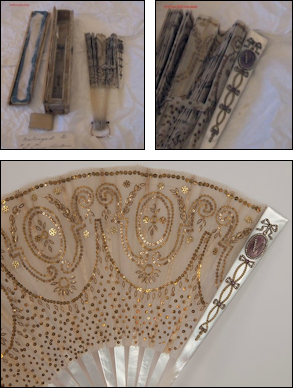 Jeweled Two-Color Gold-mounted Mother-of-Pearl and
Jeweled Two-Color Gold-mounted Mother-of-Pearl and
Guilloché Enamel Fan in Need of Restoration with
Handwritten Note ‘Belonged to H.R.H.
Princess Victoria died 1935′.
(Harewood Collection Archives, 2003)
Restored Mother-of-Pearl and Muslin Fan.
Monture – Fabergé Workmaster, Mikhail Perkhin
(Active 1899-1903)
(Fabergé: The McFerrin Collection – The
Opulence Continues … 2016, p. 63)
 Mother-of-Pearl and Gold Sequined Lace Fan.
Mother-of-Pearl and Gold Sequined Lace Fan.
Monture – Fabergé Workmaster, Mikhail Perkhin
(Active 1899-1903)
(Fabergé: The McFerrin Collection – The
Opulence Continues … 2016, p. 62)
Pleated and folded fan leaves made from an animal skin, a sheet of paper, or a fabric (silk, muslin, or lace) with added sequins by their very nature are delicate. While the Fabergé montures have survived for over a hundred years, the leaves may require restoration and/or conservation. Of special interest are two fans from the Artie and Dorothy McFerrin Collection of 14 Fabergé-mounted and Russian fans on loan to the Houston Museum of Natural Science in Texas. One of them is a muslin fan with a leaf expertly restored before it was sold at auction (Christie’s London, Harewood Collection sale, December 5, 2012,
Lot 607), and another – a lace fan – needs a bit of tender loving care from a professional fan conservator. Two groups of fan enthusiasts are active in these areas of expertise: Fan Association of North America (FANA, USA,
Fan Restoration Samples), and Fan Circle International (FCI, UK,
Conservation).
Readers Forum
Fabergé in the News
Auctions:
